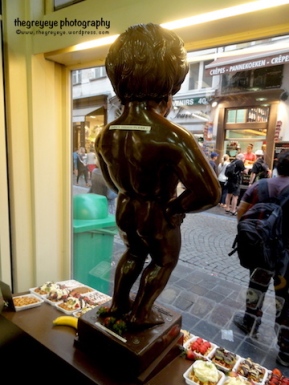

Manneken Pis has become the symbol of Brussels, like Eiffel tower for Paris.The name means in Dutch as “Little man Pee”. It is a small bronze sculpture (61 cm), depicting a naked little boy urinating into a fountain’s basin. It was designed by Hiëronymus Duquesnoy the Elder in 1618. It is not very far from the town hall, take the left lane next to the Brussels Town Hall and walk a few hundred metres southwest via Rue Charles Buls/Karel Bulsstraat. Also you can ask the pedestrians, many of them going right towards the statue.


There are many stories about the origin of Manneken pis ‘.The most famous story is about Duke Godfrey III of Leuven. In 1142, the troops of this two-year-old lord were battling against the troops of the Berthouts. The troops put the infant lord in a basket and hung the basket in a tree to encourage them. From there, the boy urinated on the troops of the Berthouts, who eventually lost the battle.
Another story is that in the 14th century, Brussels was under siege by a foreign power. The city had held its ground for some time, so the attackers conceived of a plan to place explosive charges at the city walls. A little boy named Julianske spied on them and urinated on the burning fuse and thus saved the city. As there was really an attack from French force and a history of severe fire across grand place, I wonder may be there is some truth in this legend.


Others talks about a wealthy merchant who, during a visit to the city with his family, had his beloved young son go missing. The merchant hastily formed a search party that scoured all corners of the city until the boy was found happily urinating in a small garden. The merchant, as a gift of gratitude to the locals who helped out during the search, had the fountain built. Another legend was that a small boy went missing from his mother when shopping . The woman called upon help from everyone she came across, including the mayor of the city. A city-wide search began and when at last the child was found, he was urinating on the corner of a small street.


The stories were passed down over time and the statue erected as a tribute to the well-known legend. Whatever the truth may be, Mannekin pis has become a part and parcel of Brussels common life. Chocolatiers made chocolates as his memoir, every souvenirs of the city depicts him and there is a whole wardrobe for him in the Museum of the city of Brussels. So don’t miss him, and also visit his female counterpart Jeanneke Pis .
 ©thegreyeye.wordpress.com, 2016-21. Unauthorized use and/or duplication of this material without express and written permission from this blog’s author and/or owner is strictly prohibited. All rights reserved.
©thegreyeye.wordpress.com, 2016-21. Unauthorized use and/or duplication of this material without express and written permission from this blog’s author and/or owner is strictly prohibited. All rights reserved.

What a lovely folk story, beautiful photos!
LikeLiked by 1 person
Thank you 😊
LikeLiked by 1 person
Reblogged this on Tour Suggest and commented:
Manneken Pis has become the symbol of Brussels, like Eiffel tower for Paris.The name means in Dutch as “Little man Pee”. It is a small bronze sculpture (61 cm), depicting a naked little boy urinating into a fountain’s basin. It was designed by Hiëronymus Duquesnoy the Elder in 1618.
LikeLike
We could use one of these at the White House! Just sayin… 😉
LikeLiked by 1 person
Lolz… I would love to see that
LikeLiked by 1 person
Me tooooooo! 😃😃😃
LikeLiked by 1 person
Really nice set of images.
LikeLiked by 1 person
Thank you.
LikeLike
One of my fave things from Brussels 🙂
LikeLiked by 1 person
😊
LikeLike
Brings back happy memories of walking around Brussels.
LikeLiked by 1 person
Glad that it does 😊
LikeLiked by 1 person
I like the fact that you and your pictures tell a pleasant story about Brussels. There is a “Maenneken Pis” in Dusseldorf as well, but it’s just a public bathroom 😉 http://www.bilderbuch-duesseldorf.de/Fotos/altstadt_männeken_piss_339229
LikeLiked by 1 person
O, that is great to know
LikeLike
Oh humanity… that’s a hilarious statue. He has great musculature on his back huh??
LikeLike
I love the quote in your photograph, “If you can be anything, be sweet.” I also love the history behind the photographs you took. Love this post! 🙂
LikeLiked by 1 person
Yes. That’s why I took it, simple but great quote
LikeLike
I remember when I saw it last year:) it’s a funny symbol of Brussels
LikeLiked by 1 person
Good Post. Saw this little guy in 1984. Amazing what constituted art so many years ago. On past trips to Europe, we saw grown up people emulating this statue in Edinburgh, Paris and Lyon, unknowingly, risking arrest for public urination. I wonder f they could get away with it, if they claimed they were imitating art. Allan
LikeLiked by 1 person
Haha, good thought
LikeLiked by 1 person